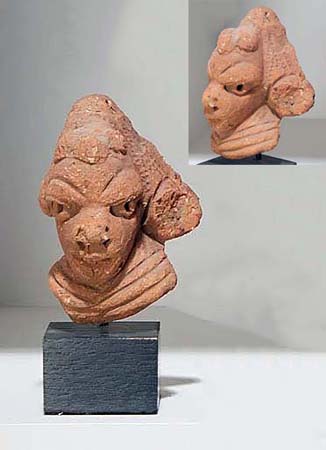
Owner: HWMC
Catalog#: 2AF-OTHR-29
Provenance: Philip Gould, Professor of Chinese Art History at Columbia University and Sarah Lawrence College.
Ritual Symbolism
Nok ‘Terracotta Head’
Nigeria, West Africa
Nok Culture
Terracotta
ca. 500 B.C.E. – 200 C.E.
Height: 3.5 inches w/o stand
Other – Ritual Symbolism
Nok sculptures are amongst the most significant archeological finds in sub-Saharan Africa as they are among the earliest examples of African art. Characteristic of this Nok culture terracotta figure head is the triangular/oval-shaped eyes and elaborate hair style.
The Nok culture appeared in Nigeria around 1500 BC and lasted approximately 2,000 year, disappearing around 500 AD for unknown circumstances. Their terracotta remains, such as this terracotta figure head are named after the Ham village of Nok in Kaduna State of Nigeria, where their terracotta sculptures were first discovered around 1928. Little is known about the Nok people other than through the discovery of their iron-smelting furnaces used to make iron tools for farming crops and weapons, and their terracotta sculptures.
Reference: · Breunig, Peter. 2014. Nok: African Sculpture in Archaeological Context: p. 21.; Fagg, Bernard. 1969. Recent work in west Africa: New light on the Nok culture. World Archaeology 1(1): 41–50.
